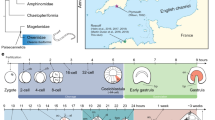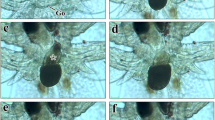Abstract
Peronella japonica, a sand dollar, forms an abbreviated pluteus larva and metamorphoses within 3 days without feeding. In the present study, the cleavage pattern of Peronella embryos was found to be quite irregular in the vegetal blastomeres at the fourth cleavage. Less than half of the embryos examined formed four typical micromeres. The majority formed zero, one, two or three typical micromeres of regular size, and the blastomere(s) remaining in the vegetal-most region was atypical in size and/or its direction of division. Most embryos were able to form pluteus larvae and a considerable proportion of these metamorphosed into juvenile sea urchins, regardless of whether or not they had formed four typical micromeres of regular size, although embryos which formed no typical micromeres developed into pluteus larvae less frequently. The micromere progeny in Peronella embryos form skeletogenic mesenchyme cells. The average numbers of skeletogenic mesenchyme cells in the three sand dollar species, Clypeaster japonicus, Astriclypeus manni and P. japonica were 62, 122 and 219, respectively. In these species, the skeletogenic mesenchyme cell-specific glycoprotein (msp130) was first detected immediately after ingression of the primary mesenchyme cells, spicules appeared at the early gastrula stage and triradiate spicules were found in late gastrulae. Appearance of these characteristics was markedly accelerated in the embryos of A. manni and P. japonica in comparison with those of C. japonicus. Each step in the formation of larval spicules was equally accelerated in A. manni and P. japonica, although the appearance of the adult skeleton was further accelerated in P. japonica in comparison with A. manni, possibly because of omission of the four- to eight-armed pluteus stages.
Similar content being viewed by others
Author information
Authors and Affiliations
Additional information
Received: 1 September 1995 / Accepted in revised form: 21 May 1995
Rights and permissions
About this article
Cite this article
Amemiya, S., Arakawa, E. Variation of cleavage pattern permitting normal development in a sand dollar, Peronella japonica: comparison with other sand dollars. Dev Gene Evol 206, 125–135 (1996). https://doi.org/10.1007/s004270050038
Issue Date:
DOI: https://doi.org/10.1007/s004270050038




